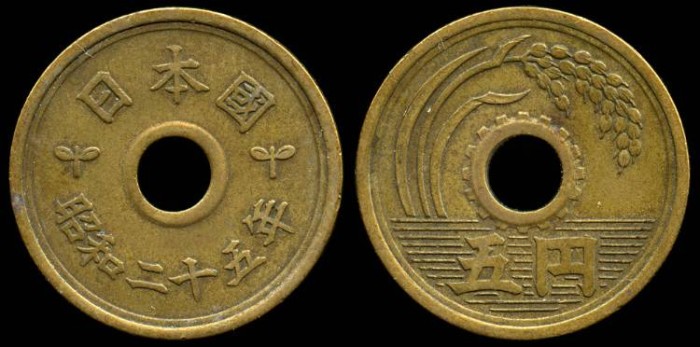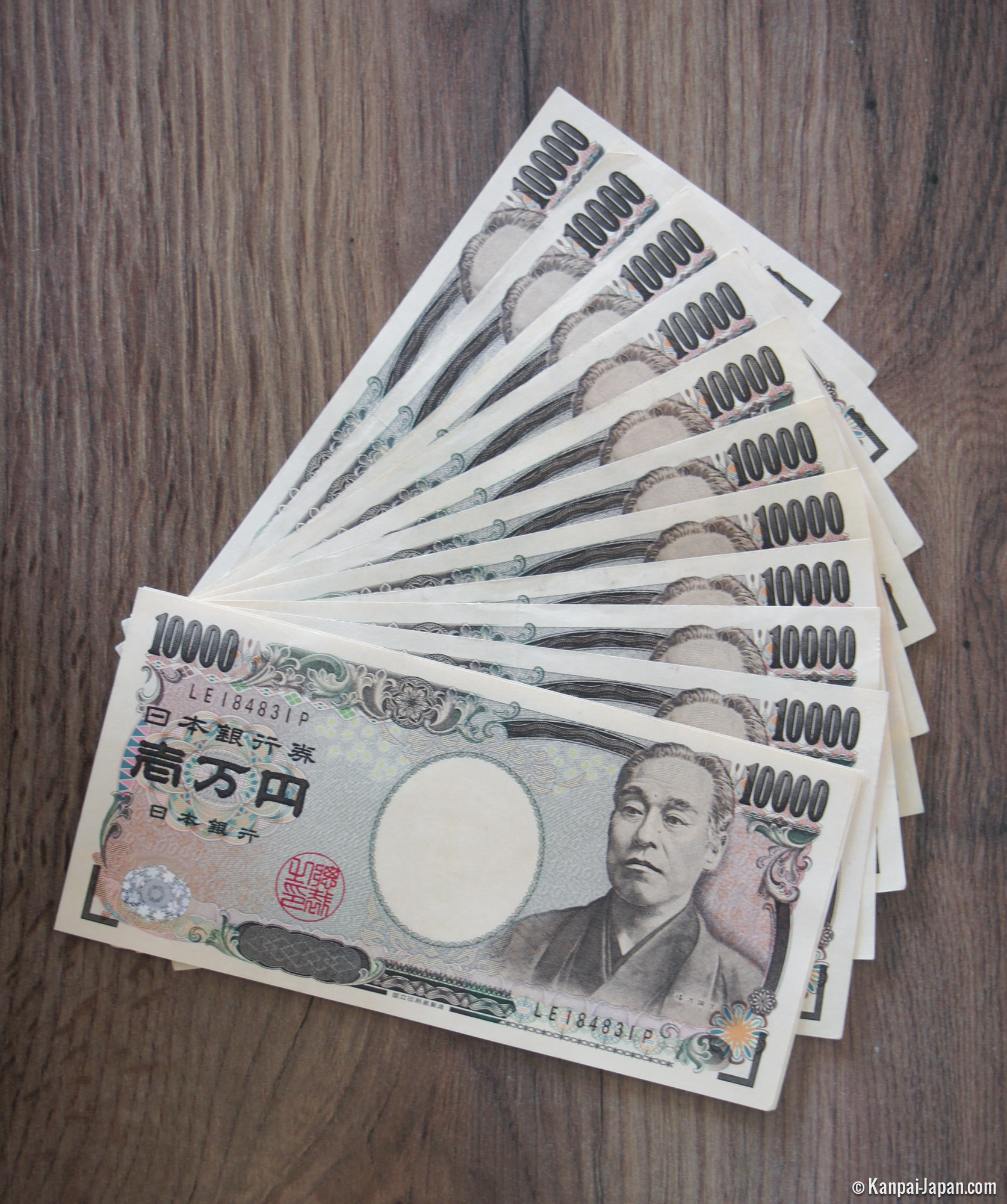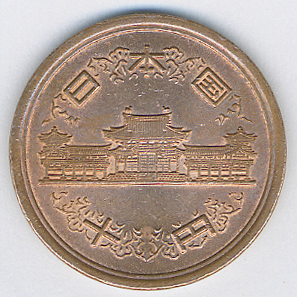
5 yen Brass Coin. The 5-yen coin with a center hole was first issued in 1949 just after the war, and its character font was changed to the current font in 1959. Japan's major industries were used as the basis for the obverse design, as Japan looked forward to postwar reconstruction.
When I was a kid, my father showed me all the books and souvenirs about and from Japan, among it a few coins. So the 5 Yen Coin has a significant meaning for me personally, because it was the very first japanese coin I ever saw or held.
The Japan Mint started issuing these 5 Japanese Yen coins in 1959. They are currently still in circulation. This Japanese gold-colored 5 yen coin has a diameter of 22mm and weighs 3.75g. Early Japanese coins like this one are enjoying strong collector interest. This pattern, with the encircled dragon on the front and two-sided wreath and blossom on the back appears on the silver coins of denomination 5, 10, 20, and 50 Sen and 1 Yen. There are 100 sen in one yen. Copper and gold coins also carry the same pattern.
But the 5 Yen coin actually holds a special place among the different coins of the japanese currency. Though it is not the only coin with a hole in it (the 50 Yen coin does have one as well), it’s the only one without arabic numerals.
The japanese word for 5 is “go” and the word Yen is pronounced “en”, which makes the pronunciation for 5 Yen “go-en”, a homophone to goen (御縁). 縁 – en means connection or relationship (sometime seven translated with “fate”), while 御 – go is the respectful prefix. Where would you want more to build a relationship, then when you are offering an Osaisen (お賽銭) – money you throw in the offering box before praying at a shrine.
I remember my new year’s eve at the Meiji Shrine in Tokyo, where they had a huge area for all the people to throw their money, since it would have taken too long for everyone to go to the offering boxes individually. The ground was covered with 5 Yen and 50 Yen coins.
Though I’m always interested in learning the meaning behind traditions, I also very much liked the explanation, a very friendly old lady told me, when she guided me through Nara on my first visit to Japan: “Always throw 5 Yen or 50 Yen coins. They have a hole in the middle and will catch the luck for you in it.”
Have you seen people throw five Yen coins or do so yourself?

One denomination of Japanese yen.Wikipedia

- 10 yen coin
One denomination of Japanese yen. The obverse of the coin depicts the Phoenix Hall of Byōdō-in, a Buddhist temple in Uji, Kyoto prefecture, with the kanji for 'Japan' and 'Ten Yen.'Wikipedia
- 1 yen coin
Smallest denomination of the Japanese yen currency. Minted in 1870, and was made out of silver.Wikipedia
- 20 yen coin
Denomination of Japanese yen. These coins were minted in gold, and during their lifespan were the highest denomination of coin that circulated in the country.Wikipedia
- 100 yen coin
Denomination of Japanese yen. First minted in silver in 1959 and saw a change of metal in 1967.Wikipedia
- 500 yen coin
Largest coin denomination of the Japanese yen. First minted in 1982, with the current design being introduced in 2000.Wikipedia
- 500 yen coin (commemorative)
Denomination of the Japanese yen. In addition to being used as circulating currency, this denomination has also been used to make commemorative coins struck by the Japan Mint.Wikipedia

- 100,000 yen coin
Denomination of the Japanese yen. Only used for the minting of commemorative coins struck by the Japan Mint.Wikipedia
- 50,000 yen coin
Denomination of the Japanese yen. Ever issued for this denomination which commemorated the wedding of Crown Prince Naruhito to Masako.Wikipedia
- 2 yen coin
Short lived denomination of Japanese yen. During the first year of mintage in 1870, hundreds of thousands of these new coins were struck.Wikipedia
- 50 yen coin
Denomination of Japanese yen. First minted in 1967.Wikipedia
- 5000 yen coin
Denomination of the Japanese yen. Only used for the minting of commemorative coins struck by the Japan Mint.Wikipedia
- 1000 yen coin
Denomination of the Japanese yen. Only used for the issue of commemorative silver coins struck by the Japan Mint.Wikipedia
- 1 sen coin
Japanese coin worth one-hundredth of a Japanese yen, as 100 sen equalled 1 yen. These coins were minted from the late 19th century until the end of World War II.Wikipedia
- 10,000 yen coin
Denomination of the Japanese yen, and is only used for the issue of commemorative coins struck by the Japan Mint. 10,000 yen coins were first issued in the mid/late 1980s in silver but were later switched to gold.Wikipedia
- 5 sen coin
Japanese coin worth one twentieth of a Japanese yen, as 100 sen equalled 1 yen. These coins were minted from the late 19th century until the end of World War II.Wikipedia
- 10 sen coin
Japanese coin worth one tenth of a Japanese yen, as 100 sen equalled 1 yen. These coins were minted from the late 19th century up until the end of World War II.Wikipedia
- 1 rin coin
Japanese coin worth one one-thousandth of a Japanese yen, as 1 rin equalled 1⁄10 sen, and 100 sen equaled 1 yen. While not in circulation any more, one rin coins are bought and sold by numismatists for academic study, and by those with a hobby.Wikipedia
- Half sen coin
Japanese coin worth one two-hundredth of a Japanese yen, as 100 sen equalled 1 yen. All half sen coins were minted during the Meiji period, and are made from nearly pure copper.Wikipedia
- 5 rin coin
Japanese coin worth one two-hundredth of a Japanese yen, as 5 rin equalled 1⁄2 sen, and 100 sen equaled 1 yen. Short lived, and succeeded the half sen coins which stopped being produced in 1888.Wikipedia
- 20 sen coin
Japanese coin worth one fifth of a Japanese yen, as 100 sen equalled 1 yen. These coins were minted from 1870 to 1911 in 80% silver.Wikipedia
- 50 sen coin
Japanese coin worth half of a Japanese yen, as 100 sen equalled 1 yen. Demonetized.Wikipedia
- 2 sen coin
Japanese coin worth one-fiftieth of a Japanese yen, as 100 sen equalled 1 yen. MeijiWikipedia
- One pound (British coin)
Denomination of the pound sterling. Its obverse bears the Latin engraving ELIZABETH II D G REG (“Dei Gratia Regina”) F D (Fidei defensor) meaning, “Elizabeth II, by the grace of God, Queen, Defender of the Faith”.Wikipedia
- Penny (Irish decimal coin)
The second smallest denomination of the Irish pound. First issued when the Irish currency was decimalised on Decimal Day, 15 February 1971.Wikipedia
- Australian one-cent coin
Lowest-denomination coin of the Australian dollar. Introduced on 14 February 1966 in the decimalisation of Australian currency and was withdrawn from circulation in 1992 .Wikipedia
- Australian two-cent coin
Introduced in 1966 and was the coin of the second-lowest denomination until it was withdrawn from circulation in 1992 . Still counted as legal tender, but is subject to some restrictions, and one-cent and two-cent coins are legal tender only up to the sum of 20 cents.Wikipedia
- One-baht coin
Denomination coin of the Thai baht, the Thai currency unit. Like all coins in Thailand, its obverse features the King of Thailand, Vajiralongkorn Bodindradebayavarangkun, and previously Bhumibol Adulyadej.Wikipedia
- Two pounds (British coin)
Denomination of the pound sterling. Its obverse has featured the profile of Queen Elizabeth II since the coin’s introduction.Wikipedia
- Fifty øre (Danish coin)
Smallest-denomination coin of the Danish krone. Since the removal of the 25 øre coin in 2008, it has been the only Danish coin with a face value of under one krone.Wikipedia
Sentences for5 yen coin
- The classroom trial in the game's fourth episode is based on real events: when Takumi was in second grade, he had found a 5 yen coin and put it in his pocket; his teacher accused him of stealing it from another student and made him apologize to her.Phoenix Wright: Ace Attorney-Wikipedia
- Examples include the Japan 5 yen coin and the Denmark 1 krone coin.Coinage shapes-Wikipedia
5 Yen Coin Both Sides 1949
This will create an email alert. Stay up to date on result for: 5 yen coin